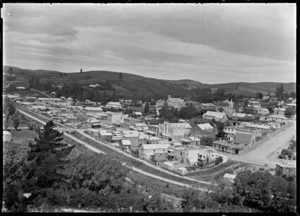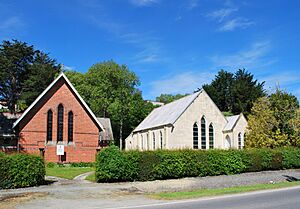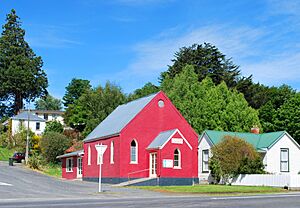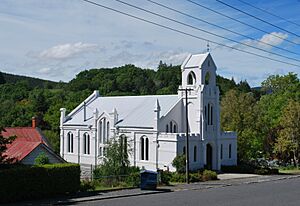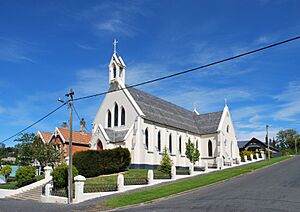Lawrence, New Zealand facts for kids
Quick facts for kids
Lawrence
|
|
|---|---|
|
Town
|
|

Ross Place (State Highway 8), the main street of Lawrence
|
|
| Country | New Zealand |
| Region | Otago |
| Territorial authority | Clutha District |
| Ward | Lawrence-Tuapeka |
| Community | Lawrence-Tuapeka |
| Electorates |
|
| Area | |
| • Total | 2.19 km2 (0.85 sq mi) |
| Population
(June 2023)
|
|
| • Total | 470 |
| • Density | 214.6/km2 (556/sq mi) |
| Time zone | UTC+12 (New Zealand Standard Time) |
| • Summer (DST) | UTC+13 (New Zealand Daylight Time) |
| Postcode |
9532
|
| Local iwi | Ngāi Tahu |
Lawrence is a small town found in Otago, which is a region in New Zealand's South Island. It sits on State Highway 8, an important road connecting Dunedin to popular inland towns like Queenstown and Alexandra. The town is near the Tuapeka River, which flows into the larger Clutha River.
Contents
Discovering Lawrence's Past
The history of Lawrence began with a huge discovery. In May 1861, a man named Gabriel Read found gold at a place called Gabriel's Gully. This started the famous Otago gold rush. Within a year, the goldfield's population exploded to about 11,500 people. This was twice the number of people living in Dunedin at the time! Gabriel's Gully quickly filled with tents, mining sites, shops, and government buildings.
By December 1861, around 14,000 people were in the Tuapeka goldfield. This number kept growing, reaching about 24,000 by February 1864. Many miners were from England and Ireland, but others came from Europe and China. The land under the makeshift town also had a lot of gold. So, the shops and government services moved about 3 kilometres (1.9 mi) away to a new spot at the entrance of the Gully. This new area did not have gold.
How Lawrence Got Its Name
A new town was planned in 1862 by Robert Grigor. It was first called Tuapeka. Land in the town was sold at an auction on November 5, 1862. By 1864, most people had moved from the old tent town to this new area. It quickly became the main hub for Otago's goldfield. It had a bank, hotels, hardware stores, clothing shops, a watchmaker, and many other businesses. The town became an official municipality in 1866. It was then renamed Lawrence to honor Sir Henry Lawrence, a hero from a military campaign in 1857.
In the 1870s, large-scale gold mining using water jets caused floods in the lower parts of the town. This made government buildings, churches, and schools move up the hill to Colonsay Street. Peel Street became the main business street. By 1870, a settlement of Chinese miners just outside town had 300 residents. The Black Horse Brewery opened in Lawrence in 1866 but closed in 1923.
Did you know that the music for New Zealand's national anthem was created in Lawrence? John J. Woods, a school teacher in Lawrence, composed it.
Lawrence's Railway and Modern Times
In 1877, a branch line railway was built to Lawrence from the Main South Line. Lawrence was the end of this railway line until it was extended in 1910. This line later became known as the Roxburgh Branch. The railway closed in 1968. The town's old train station is gone, but some parts of the railway, like the goods shed, can still be seen.
In 1978, two lions, Sultan and Sonia, escaped from a circus in Lawrence. The police had to deal with them. The lions were later stuffed and are now on display at the Otago Museum.
In 2011, Lawrence became the first town in New Zealand to offer free Wi-Fi internet to everyone in town.
The Lawrence Rugby Football Club is based in the town. Lawrence also has a sister city, Jacksonville, Oregon, in the United States.
Lawrence's Population
Lawrence is a rural settlement. It covers about 2.19 km2 (0.85 sq mi). As of June 2023, it had an estimated population of 470 people.
Places to See in Lawrence
Lawrence has several historic churches that tell the story of its past.
Holy Trinity Anglican Church
People started planning the first Anglican Church in Lawrence in December 1866. The first clergyman, Rev. H.W. Martin, arrived from Australia in February 1868. At first, Anglicans held services in the Methodist Church. Then, they built their own wooden church on Whitehaven Street. It opened in May 1871.
A wooden belltower was built next to the church in the late 1890s. This belltower was kept when the old church was taken down to build the current brick church. The new church was designed by architect E. R. Wilson. Its foundation stone was laid in March 1925, and it was officially opened in August of the same year. The belltower was repaired and rededicated in 1980. It was recognized as a historic place in 2005. The church held its last service in January 2015 and was sold in 2016 to become a holiday home.
Lawrence Methodist Church
The first Methodist services in the area were held in two canvas churches in 1862. These were later replaced by a permanent church in Gabriel's Gully in 1870. In Lawrence itself, a brick Methodist church was built on Colonsay Street and opened in 1865. However, a mistake in surveying meant part of the building was on Catholic land. It was used for eight years, then taken down. A new wooden church was built on Whitehaven Street and opened on September 14, 1873.
Lawrence Presbyterian Church
The first Presbyterian services were held outdoors at Gabriel's Gully in July 1861. By 1864, enough money was raised to build a wooden church on Colonsay Street. The church's first permanent minister was Reverend Dr James Copland.
By the mid-1880s, people decided to build a new church on the same land. The new building, designed by architect R.A. Lawson, opened in September 1886. The old church building stayed and was used as a Sunday School. The new church was made of red brick with stone foundations. It was the first church in Otago to have an organ.
The church was sold around 1994. In 1998, a fire badly damaged the building. In 2002, Jo and Mike Romanes bought the church. They spent six years fixing it up, adding a new roof and floor, and turning it into a special place to stay. The building was recognized as a historic place in 2004.
St Patrick’s Roman Catholic Church
When gold was discovered, many Irish Catholics moved to Otago. To serve their spiritual needs, Father Delphin Moreau began visiting the goldfields from Dunedin. He would walk to Tuapeka and hold Mass once a month. By 1862, he was holding Mass every other Sunday in a tent in Gabriel's Gully. In October 1863, local businessman John Donovan donated land for a church and school. In 1864, Father Joseph Eccuyer became the first priest to live permanently in Lawrence. A corrugated iron church called St Gabriel’s was built there and blessed in November 1864. It was the first Catholic church in Otago.
By May 1871, Father William Larkin was appointed Parish priest. He organized the building of the large wooden St Patrick’s church-school, which opened on March 17, 1872. People soon wanted a separate church that was not also a school. A fund for a new church started in 1880. Famous architect Francis Petre was chosen to design it. Construction began in November 1890.
The new brick Gothic church, with seating for about 600 people, officially opened on January 6, 1892. A convent for Dominican nuns was built next to the church and opened in 1893. In 1902, a Presbytery (a house for the priest) was built nearby. The church was covered in roughcast in 1926 to protect its bricks. In the 1990s, the church needed major repairs, which were done in 1995. The Presbytery is still owned by the Church but is now rented out.
Education in Lawrence
Lawrence Area School is a school for students from Year 1 to Year 13 (ages 5 to 18). It is a co-educational state school. It also provides high school education for students from Waitahuna School.
In the past, Lawrence had other primary schools. Blue Spur School closed sometime between the 1930s and 1940s. Forsythe School closed in the 1960s. St Patrick's School closed at the end of 1980. Now, Lawrence Area School is the only school left in Lawrence.
Famous People from Lawrence
- Archibald Durward FRSE (1902–1964) lived here when he was young.
- James Graham (1884–1941) was an Otago rugby player and an All Black (1913–14).
- Frank Mitchinson (1884–1978) was also a rugby union player.
- Frank Oliver (1948–2014) was a rugby player and coach, and an All Black (1976–81). He went to Lawrence District High School.
- Ella Spicer (1876–1958) was a painter.
- Jack Williams (1918–1975) was a Member of Parliament.
- David Wilson, who is the 14th Clerk of the New Zealand House of Representatives (since 2015), grew up in Lawrence.


